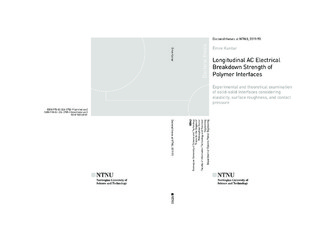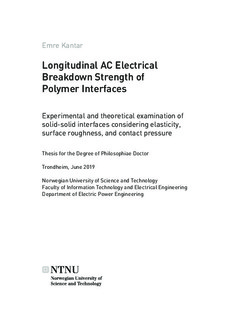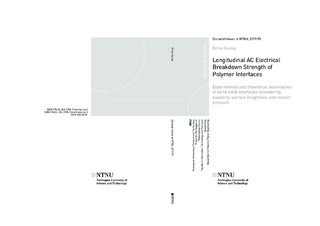| dc.contributor.advisor | Ildstad, Erling | |
| dc.contributor.author | Kantar, Emre | |
| dc.date.accessioned | 2019-07-22T12:42:03Z | |
| dc.date.available | 2019-07-22T12:42:03Z | |
| dc.date.issued | 2019 | |
| dc.identifier.isbn | 978-82-326-3785-0 | |
| dc.identifier.issn | 1503-8181 | |
| dc.identifier.uri | http://hdl.handle.net/11250/2606181 | |
| dc.description.abstract | All electrical insulation systems consist of a combination of different insulating and conductive materials. The alternating current (AC) breakdown strength (BDS) of insulation systems is limited by the lowest BDS of either the insulating bulk materials or the interface between adjacent insulating materials. The interfacial breakdown between two solid dielectric surfaces has been reported to represent one of the principal causes of failure for insulation systems; thus, a better understanding of the mechanisms governing the solid-solid interface breakdown is vital. Therefore, the main objectives of this work are to examine the practical limitations regarding electrical breakdown strength of interfaces between solid-solid insulating components and to address the main mechanisms leading to a solid-solid interface breakdown. Individual effects of the contact pressure, surface roughness, elastic modulus of the polymers, and insulating dielectric medium surrounding the interfaces (i.e., air, water, or oil) on the longitudinal/tangential AC breakdown strength of solid-solid interfaces are studied, both theoretically and experimentally.
When two nominally flat solid materials are brought into a contact, an interfacial contact occurs at discrete spots, resulting in numerous microcavities between adjacent contacting areas at the interface due to imperfect, non-ideal surfaces. An interface thus consists of cavities and contact spots connected to each other. A hypothesis is proposed considering the imperfect surface texture of solid-solid interfaces: the breakdown strength of a solid-solid interface can be represented by the breakdown strength of strings of cavities and contact spots formed at the interface between the electrodes. In other words, size, shape and surrounding medium inside the cavities are assumed to determine the dielectric strength of the cavities whereas the insulating properties of the contact spots presumably also have a significant impact on the interfacial breakdown strength. To fulfill the objectives of the thesis presented above, the hypothesis was tested using experimental and theoretical studies conducted during the PhD period. To structure and represent the hypothesis analytically, an interface breakdown model was developed that focuses on the discharge of cavities and breakdown of contact areas, separately.
Two different theoretical approaches for modeling contact surfaces at solid-solid interfaces were used: a statistical and a deterministic/numerical interface contact models, that were developed based on tribology of polymeric materials. The statistical model was primarily used to develop the interface breakdown model. The main purpose of developing the deterministic model was, on the other hand, to support the outputs of the interface breakdown model by simulating the deformation of the surface asperities in 2D and 3D as a function of the contact pressure, surface roughness, elasticity, and hardness of the solid material. Simulation results on the interfacial deformation cast light on how cavities are connected in 3D and elucidate the resulting gas pressure inside the cavities, which could not be estimated using the 2D statistical interface contact model solely.
Experimental studies on the solid-solid interfaces consisted of three different types of testing: AC breakdown strength testing, AC partial discharge inception field testing, and interface discharge-monitoring testing under AC excitation. In the experiments, two rectangular prism-shaped samples were placed vertically between two Rogowski-shaped electrodes. In the AC breakdown experiments and partial discharge (PD) inception field measurements, four different interfaces formed between identical polymers were used. The selected polymers were silicone rubber (SiR), cross-linked polyethylene (XLPE), filled epoxy resin (EPOXY), and polyether ether ketone (PEEK) that have different elasticity and electrical insulation properties. In addition, the surface roughness was varied by sanding the surfaces using four different sandpapers of different roughnesses with grit numbers: #180, #500, #1000, and #2400 from roughest to the smoothest in a sequence. In the discharge-monitoring experiments, in contrast to the AC breakdown and PD experiments, a very smooth glass sample in the same size of the polymer sample at the bottom was utilized as a transparent solid material to enable the camera to monitor light originating from the discharges at the glass-polymer interface.
The results of the experimental and theoretical studies have indicated that different mechanisms are involved in the breakdown of solid-solid interfaces. The main hypothesis has been verified through the results of the experimental and theoretical studies. The main findings are briefly summarized below.
The interfacial breakdown in the cases of materials with low elastic moduli (softer materials) such as SiR and XLPE has been found to be strongly dominated by the discharged cavities due to their low estimated interface tracking resistances. (The estimated interface tracking resistance is linearly correlated with the fourth root of elastic modulus). In other words, discharged cavities have led to an interfacial failure more easily because the contact spots could not withstand the enhanced fields. Besides, varied surface roughness in the case of XLPE–XLPE interfaces has yielded parallel results such that the clear correlation between the cavity discharge and the interface breakdown have been maintained irrespective of the surface roughness. On the other hand, in the cases of materials with higher elastic modulus such as EPOXY and PEEK, the endurance of the contact spots against the local enhanced fields has been observed to be higher due to the increased estimated micro-tracking resistance. To summarize, the results have suggested that the influence of the contact spots on the interface breakdown becomes more prominent at higher contact pressures, higher elastic modulus (harder materials), or smoother surfaces. | nb_NO |
| dc.language.iso | eng | nb_NO |
| dc.publisher | NTNU | nb_NO |
| dc.relation.ispartofseries | Doctoral theses at NTNU;2019:93 | |
| dc.relation.haspart | Paper 1: Kantar, Emre; Panagiotopoulos, Dimitrios; Ildstad, Erling. Factors influencing the tangential AC breakdown strength of solid-solid interfaces. IEEE transactions on dielectrics and electrical insulation 2016 ;Volum 23.(3) s. 1778-1788
- Is not included in NTNU Open due to copyright.
Available at
https://doi.org/10.1109/TDEI.2016.005744 | nb_NO |
| dc.relation.haspart | Paper 2: Kantar, Emre; Mauseth, Frank; Ildstad, Erling. Effect of pressure and elastic modulus on tangential breakdown strength of solid-solid interfaces. I: IEEE Electrical Insulation Conference (EIC), 2016. IEEE conference proceedings 2016 ISBN 978-1-4673-8707-1. s. 431-435
https://doi.org/10.1109/EIC.2016.7548630 | nb_NO |
| dc.relation.haspart | Paper 3: Kantar, Emre; Mauseth, Frank; Ildstad, Erling; Hvidsten, Sverre. Longitudinal AC Breakdown Voltage of XLPE-XLPE Interfaces Considering Surface Roughness and Pressure. IEEE transactions on dielectrics and electrical insulation 2017 ;Volum 24.(5) s. 3047-3054
- Is not included in NTNU Open due to copyright.
Available at
https://doi.org/10.1109/TDEI.2017.006540 | nb_NO |
| dc.relation.haspart | Paper 4: Kantar, Emre; Hvidsten, Sverre; Mauseth, Frank; Ildstad, Erling. A stochastic model for contact surfaces at polymer interfaces subjected to an electrical field. Tribology International 2018 ;Volum 127. s. 361-371
https://doi.org/10.1016/j.triboint.2018.03.003 | nb_NO |
| dc.relation.haspart | Paper 5: Kantar, Emre; Ildstad, Erling; Hvidsten, Sverre. Effect of Material Elasticity on the Longitudinal AC Breakdown Strength of Solid-Solid Interfaces. IEEE transactions on dielectrics and electrical insulation 2019 ;Volum 26.(2) s. 655-663
- Is not included in NTNU Open due to copyright.
Available at
https://doi.org/10.1109/TDEI.2019.008087 | nb_NO |
| dc.title | Longitudinal AC Electrical Breakdown Strength of Polymer Interfaces: Experimental and theoretical examination of solid-solid interfaces considering elasticity, surface roughness, and contact pressure | nb_NO |
| dc.type | Doctoral thesis | nb_NO |
| dc.subject.nsi | VDP::Technology: 500::Electrotechnical disciplines: 540::Electrical power engineering: 542 | nb_NO |


